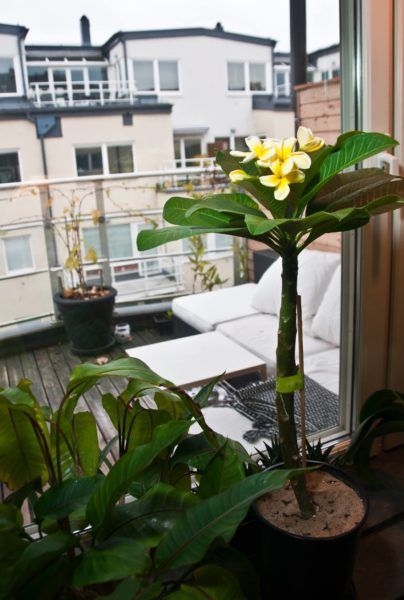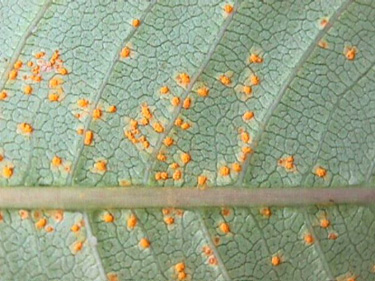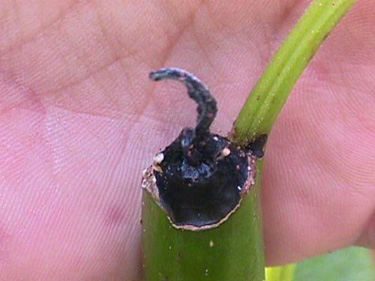Plumeria is a beautiful plant that is a genus of about 11 species in the dogbane family. Plumeria plant is native to tropical America, Mexico, and the Caribbean. Plumerias are tropical plants and are mostly planted as an ornamental plants found in tropical and subtropical regions. Plumeria flowers are of a wide variety and various bright colors. Growing plumeria in tropical regions is very common. In fact, Plumeria Alba, one of the species of Plumeria is the national flower of Laos.
Key Takeaways
Plumeria grows well in the spring and summer months. Hence, for healthy and new growth of the plant and flowers to bloom, it is important to keep it away from the hardiness zone.
For full growth of the plant, you have to make sure to avoid any type of pest infestation, or tip rot, and avoid growing during the dormant period, that is during winters.
To encourage plumeria growth during winter, you need to provide the plumeria winter care, like preparing the soil with the best quality potting mix.
Along with the potting mix, add peat moss to intensify the acidity and oxygenation.
You know well that plumeria is a tropical plant. The roots of Plumeria are found in central and South America. It is much famous in Hawaii, called as Hawaiian Lei Plant So if you’ve ever been to Hawaii, there’s a good chance you’ve seen and loved plumeria. This plant’s waxy blossoms are the standard flower for constructing authentic Hawaiian leis, and its sweet aroma is symbolic of the tropics.
Yet as long as you adhere to a few rules, plumeria is actually pretty simple to grow just about anywhere. This means you can grow plumeria outdoors and as indoor plants as well. Before moving further and getting into the details of growing plumeria indoors, let’s first have a quick glance at the structure of the plumeria tree.
If we talk about the morphology of the plumeria plants, then it has thick and hard branches which have a milky sap in them which is inflammatory and may cause skin infections like dermatitis. Apart from this, it has long fleshy leaves.
The Plumeria flower is considered an ornamental flower. The planting of plumeria plants is not so difficult, yet not so easy as well. Growing plumeria requires a lot of care. To ensure the best-blooming flowers of the plant, it is important for all gardeners to know the right conditions and environment to be provided for it.
Generally, Plumeria is grown outdoors in an open environment, but Plumeria can be easily grown indoors too. Just you need to provide the exact and perfect growing conditions for the plant to thrive indoors.

Here in this article, you will get to know a detailed account of how to grow plumeria indoors. The necessary elements required for the healthy growth of plumeria indoors are enough sunlight, regular watering, and planting the plant in healthy soil. Apart from that, keeping an eye on the growth of plants by providing them supplements like, potting soil, fertilizers, etc also helps the plants to grow and blossom nicely.
Light and Temperature Requirements of the Plant
Like any other healthily growing plant, the plumeria plant also requires proper light and adequate temperature for growth. We know that plumeria is a summer plant that grows in the early spring season. For a Plant to grow plumeria flowers are very beautiful, so it is important to provide it the bright light and fresh soil for producing fragrant flowers.
Bright Sunlight
Because plumeria is a tropical plant, they do not fare well in cold areas. For some of us, this simply means putting potted plumeria trees in a sunny window, but for others, it can be a little more difficult to meet the lighting needs of the plumeria that are in bloom.
Plumeria really enjoys a position that is bright and sunny and a few meters away from a window that faces south. Your natural inclination when growing potted plumeria flowers is to give them as much light as they can receive, but keep in mind that humidity in hot weather increases with distance from the equator.
A plumeria can avoid stem rot, avoid root rot, and fend off spider mites with just aeration and warm temps. Any longer than six hours a day in direct sunlight will exacerbate some of these issues with plumeria trees. Ideally, they actually like light that is diffused via other plants, such as hanging tropicals that soak up the strongest heat and let sufficient sunlight through for your frangipani.
For better growth of Plumeria, it is recommended for the plant to have full sun. Full sun is defined as 6–8 hours a day of uninterrupted, direct sunshine. This entails planting indoor plants within a meter of a south-facing window.
Perfect Temperature

As far as temperature is concerned plumeria plants grow best in USDA zones. Plumeria plants are intolerant to winters or low temperatures. The maximum minimum temperature plumeria plant can bear is about 10 degrees centigrade. If the temperature crosses the limit then the parts exposed to the falling temperature may die.
The best-suited temperature for planting plumeria plants indoors is between 65 degrees to 80 degrees Fahrenheit or 18 to 27 Degree celsius. If in case the temperature falls below 10 ゚C then the plant will go dormant and start to go dormant and start to drop its leaves.
Protecting Plants from Extreme Temperatures
Plumeria requires a lot of care. They need frequent fertilizing as well as strict monitoring to avoid illnesses and pests including blacktip fungus, mealybugs, and spider mites. But during the winter, this can be even more challenging because, when grown outside of their native tropics, they require serious attention to avoid root rot, stem rot, frost damage, and branch dead wood, all of which can either completely kill the small trees or prevent them from flowering regularly the very next year.
It’s essential to winterize plumeria for a strong plant in the spring. Winterizing is the practice of properly preparing your sensitive plants for winter, not merely moving them.
If the temperature falls below 50F, plumerias won’t be able to recover from the harm caused by the frost. They ought to be over 60F, and if possible, even 75F. Overwintering plumerias that are cultivated inside is simple.
Cut back any unhealthy, diseased, or damaged growth, clear the area around the plant’s base of fallen leaves, and suspend watering for a few months. They will become dormant and stop developing as the days get shorter in the winter. In the spring, they will spontaneously start to grow afresh.
Watering and Fertilizing the Plumeria Plants
Taking care of plumeria is neither too easy, nor too difficult. The gardeners need to know the right quantity of water and fertilizers to be provided to the plant outdoors and indoor plants. The simple technique of watering plumeria plants indoors is to water the plant deeply, so that the water reaches the roots of the plant, and goes for the next watering until the soil dries out.
The same is the case with fertilizers. When growing plumeria indoors, you need to provide fertilizers to the plant every two-four weeks. good quality fertilizers help to grow plumeria faster.
Mid-fall is the best time to cut back on watering, and after the plants go into dormancy for the winter, fully cease. Once springtime arrives and fresh growth starts to develop, start watering again. A fertilizer with a high phosphate content, such as 10-30-10, will support plumeria flower blossoming. A surplus of nitrogen will only promote rapid leaf growth and minimal blooming.
Watering Schedule for Plumeria Plants
There is no such fixed watering schedule for plumeria plants. What is to be kept while taking care of the plants is to keep a check that whether it has moisture in the soil or not. Never allow the plant to run out of moisture ever.
Although there are no such watering patterns, you can water the plants according to your convenience. There are two ways to water indoor plumeria or in a heated greenhouse.
One is, when you water the plant, once a week. Water a bit and every two to four weeks, fertilize the plant.
Another one is watering plumeria plants when they have completely dried out. You need to determine whether there is still any moisture in the top two inches of the soil using water meters or a straightforward finger test. Do not water the soil if it is even slightly wet.
After it dries out, totally soak the pot until the water flows through the openings at the bottom of the pot.
Best Soil for Plumeria Plants
Growing inside is frequently simpler because you may occasionally swap out the dirt. Like many other plants, plumerias require a lot of drainages. This commonly enters potted plants through the holes drilled at the bottom of the pot. But, putting an additive to the containers as well as the garden might assist lower the possibility of saturated soil from powerful storms.
For a planted Plumeria plant, add a bottom layer of fine tiny pebbles before filling the container with soil. A great, loam with a little acidity tends to be preferable, as this kind is open, well-draining, and has abundant organic matter.
The organic matter doesn’t merely fuel your plant between Plumeria fertilizer treatments. It also stimulates earthworms and other organisms, which help aerate the soil.
Common Issues with Planting Plumeria and Solutions to it
In a dry climate, particularly during the summer season, plumerias are often not afflicted by most fungal infections. Yet, these frequent illnesses can emerge during the milder winter months, particularly if the soil is left wet or your plants are overwatered. Some fungal infections are also possibly contagious in young-rooted cuttings.

RUST FUNGUS:
Plumeria is one of several plants that can get rust diseases or rust fungus. Rust is generally somewhat particular about the hosts it may live on. Many rusts include several types of tiny spores.
Such variants allow the fungus to live throughout the year on one parent and for part of it on another, infecting two completely distinct plants.
Plumeria rust is a fungal infection that has become well-known for its noticeable, granular, yellow-orange blemishes on leaves. The presence of yellow, orange or reddish-brown granular abscesses on the foliage, stems, or buds of the diseased plant can always be identified.
These pustules release spores that are then spread to nearby healthy plants, where they cause new infections, by splattering rain or air currents.
BLACKTIP FUNGUS:
If it has a significant head start, Black Tip Fungus is exceedingly difficult to manage. Black Tip can show up throughout the course of the year, although it often attacks in the early summer and the fall. Black Tip Fungus prefers gloomy, damp, and chilly environments. When the circumstances are ideal, they may almost appear overnight and grow exponentially.
If left unchecked it will destroy the growing tips of established trees, and kill totally a little plumeria. As the weather warms up after Black Tip has destroyed the growing tips on a mature plumeria, Black Tip will disappear. The blackened tips will calluses and separate at that point.
The plumeria will then start to spread out again as if it had been clipped. When a tree grows a lot of new branches, it’s not always terrible, but if it does it frequently, it will be difficult to get your plumerias to blossom.

Solutions to the Issues
1. Search for Longhorn Borer Symptoms
Look for little holes seeping a dark material on the plumeria stems. During winter pruning, remove any branches that are twisted or shriveled by punching these holes at the base.
2. Look for Black Mold
Leaves with white or black dots may have a dual issue. Whiteflies may congregate on the underside of leaves and exude a sticky material, which then promotes the growth of black sooty mold. Both of these issues may be solved with fungicide treatment and insecticidal soap.
3. Check for Cutworms on the Plant.
Slugs and snails prefer to attack one region at a time and leave slime trails behind them, but cutworms will eat any portion of the plumeria plant. Dursban or diazinon applied to the soil will stop cutworms in their tracks. Diatomaceous earth can be used to discourage snails and slugs.
4. Look for Pill Bugs and Aphids.
Keep an eye out for any parts of the plant which appear to be coated with any unusual chemicals. Sticky coatings on plants are sometimes an indication of insect activity. A garden hose spray of water helps flush off aphids.
5. Maintain a Clean Yard
Periodically rake up trash from the tree as appropriate housekeeping procedures aid in the prevention of illnesses and issues.
Conclusion
To conclude the article, it can be said that Plumeria is both an indoor and outdoor plant. All that it needs for proper growth is natural light, adequate drainage, and good quality fast draining soil that is rich in coarse sand.
Also, for the growth of various colorful flowers like white flowers, you should provide adequate fertilizers and maintain well-draining soil.
Frequently Asked Questions
Although the plumeria plant thrives well in the full Sun outdoors for endorse you can place the plumeria plant near a south-facing window that receives enough light for at least 5 to 6 hours.
Plumeria should ideally grow in areas where the average temperature ranges from 65 to 80 degrees Fahrenheit. The plant will lose its leaves and become dormant if the temperature falls below 50°F.
Once you have 2 to 3-inch leaves, you only need to water them every 2 to 3 weeks. Once they have sprouted leaves and rooted, regular watering can resume.
Growing plumeria even indoors requires fertilizers. One element for the growth and blooming of plumeria flowers is phosphorus. Apart from that, nitrogen is an important element that induces the growth of indoor plumeria.
Although there aren’t many issues with plumeria, they can be vulnerable to spider mites and other common greenhouse pests like mealybugs and white flies. These pests can be managed with neem oil and insecticidal soap.
Even yet, it’s quite rare for Plumeria blooms to blossom indoors. Indoors, in a location with lots of light, plumerias flourish.
Cuttings of plumeria can be made as deeply as 30 cm into the stem without causing damage to the plant. You can remove any branches or limbs that block your path or that you feel don’t look very good. Cutting your plant all the way down to the soil is the only way to over-prune it.
Over-Watering of Plumeria indoors- Wilting, yellowing, and falling leaves, Suddenly seeming ill, Being plagued by pests or diseases.
Under-Watering of Plumeria indoors- Slow growth, wilting, dry soil, and dry, dead leaf tips
Yes, plumeria can be easily propagated indoors. Remove all stalks of flowers and flower buds. Cut all but two of the leaves at the cutting’s tip as well to stimulate the cutting’s vitality to go towards developing new roots. Cover the cutting’s tip with plastic wrap or place it in a container filled with wet coconut coir. So that the end develops a callus, let it sit for two weeks.
Generally, there aren’t many issues with plumeria, they can be vulnerable to spider mites and other typical greenhouse pests like mealybugs and white flies. These insects can be managed using insecticidal soap.
View More Related Posts:
